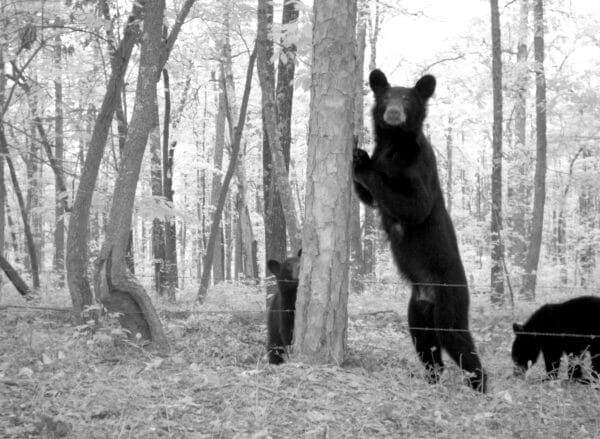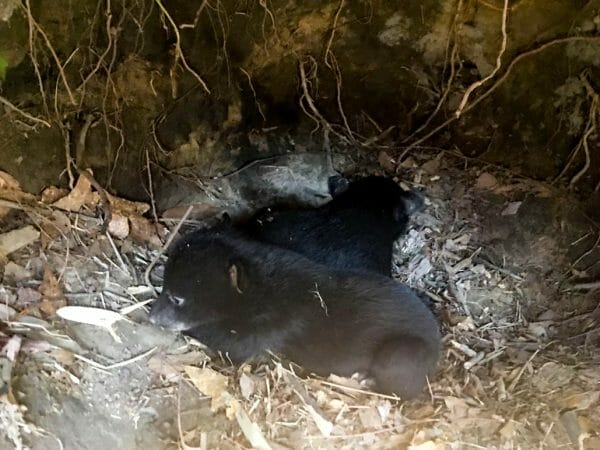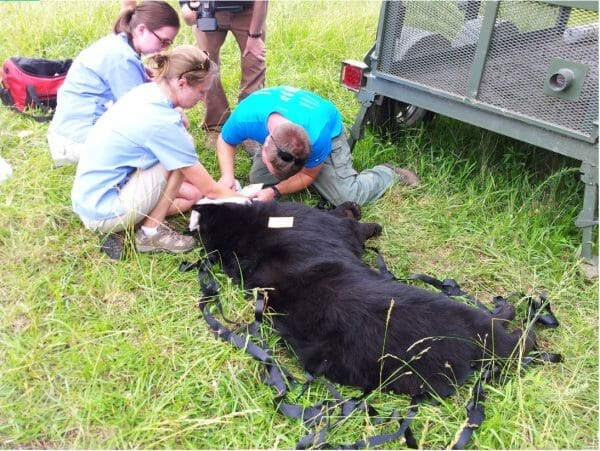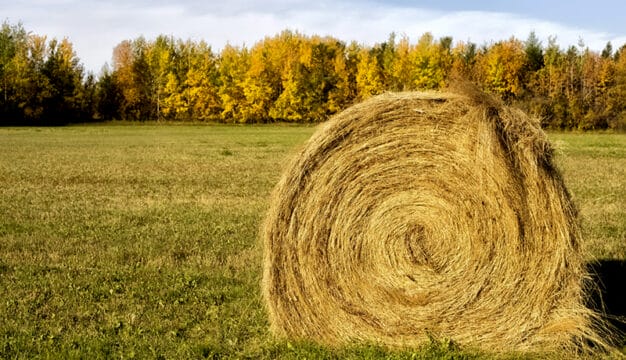American Black Bear
 Black Bear
The American black bear (Ursus americanus) is a large omnivorous mammal in the Ursidae family, which includes the much-larger Alaskan brown bear, the polar bear, and the giant panda. The family is fairly recent in evolutionary history, with the first identifiable members dating to the late Eocene (approximately 38 million years ago). The two subspecies of American black bear found in Alabama are the Florida black bear (Ursus americanus floridanus) and the Louisiana black bear (Ursus americanus luteolus). The bear’s genus name derives from the Latin for “he-bear,” and the species name refers to its distribution in North America. The American black bear is found in 41 states of the United States and 43 counties across the state of Alabama and in parts of Canada and Mexico. In Alabama, the largest numbers of black bears are found around Little River Canyon in Cherokee County in the northeastern part of the state and in Mobile and Washington Counties north of Mobile.
Black Bear
The American black bear (Ursus americanus) is a large omnivorous mammal in the Ursidae family, which includes the much-larger Alaskan brown bear, the polar bear, and the giant panda. The family is fairly recent in evolutionary history, with the first identifiable members dating to the late Eocene (approximately 38 million years ago). The two subspecies of American black bear found in Alabama are the Florida black bear (Ursus americanus floridanus) and the Louisiana black bear (Ursus americanus luteolus). The bear’s genus name derives from the Latin for “he-bear,” and the species name refers to its distribution in North America. The American black bear is found in 41 states of the United States and 43 counties across the state of Alabama and in parts of Canada and Mexico. In Alabama, the largest numbers of black bears are found around Little River Canyon in Cherokee County in the northeastern part of the state and in Mobile and Washington Counties north of Mobile.
 Bear and Cubs in Little River Canyon
The American black bear ranges from black to light brown or beige in some subspecies. In areas where their ranges overlap, American black bears can be similar in appearance and overlap in range with brown bears, but black bears have longer, less furred ears, less of a hump on their shoulders, and a straight and short, less curved snout. However, the black bear is the only species of bear found in Alabama. They may live up to 30 years in the wild. Black bears are large but vary greatly in size depending on the season, age, and sex. Males typically average between 150 and 350 pounds (68-160 kilograms) and females range from 120 to 250 pounds (54-113 kilograms). The largest male recorded thus far was over 900 pounds. Black bears range from 47-79 inches (~120 to 200 centimeters) in length and have small eyes and ears, sharp canine teeth, although they rarely prey on large animals, and enlarged molars to grind vegetation, which is the staple of their diet. They also use their sharp, curved claws to climb and dig for food.
Bear and Cubs in Little River Canyon
The American black bear ranges from black to light brown or beige in some subspecies. In areas where their ranges overlap, American black bears can be similar in appearance and overlap in range with brown bears, but black bears have longer, less furred ears, less of a hump on their shoulders, and a straight and short, less curved snout. However, the black bear is the only species of bear found in Alabama. They may live up to 30 years in the wild. Black bears are large but vary greatly in size depending on the season, age, and sex. Males typically average between 150 and 350 pounds (68-160 kilograms) and females range from 120 to 250 pounds (54-113 kilograms). The largest male recorded thus far was over 900 pounds. Black bears range from 47-79 inches (~120 to 200 centimeters) in length and have small eyes and ears, sharp canine teeth, although they rarely prey on large animals, and enlarged molars to grind vegetation, which is the staple of their diet. They also use their sharp, curved claws to climb and dig for food.
 Baby Black Bears
American black bears reproduce, on average, every two years after they reach maturity, which is at around three and a half years. Breeding times can vary depending on environmental and human-caused pressures. The average mating season starts in May and ends by mid-July. American black bears are polygynous, meaning one male mates with multiple females during each mating season. Gestation does not begin, however, until the female has consumed enough food and gained enough fat. Cubs are normally born in January or February in litters that average around two to three cubs. Denning occurs in caves, tree cavities, underground chambers they dug out, root masses, and even in above-ground nests. Bears in Alabama generally do not hibernate as they do in colder climates, although they may sleep for longer periods in winter than in warmer seasons.
Baby Black Bears
American black bears reproduce, on average, every two years after they reach maturity, which is at around three and a half years. Breeding times can vary depending on environmental and human-caused pressures. The average mating season starts in May and ends by mid-July. American black bears are polygynous, meaning one male mates with multiple females during each mating season. Gestation does not begin, however, until the female has consumed enough food and gained enough fat. Cubs are normally born in January or February in litters that average around two to three cubs. Denning occurs in caves, tree cavities, underground chambers they dug out, root masses, and even in above-ground nests. Bears in Alabama generally do not hibernate as they do in colder climates, although they may sleep for longer periods in winter than in warmer seasons.
Black bears are opportunistic eaters, feeding on new vegetation and animal carcasses, insects, fish, and larger animals after they emerge in the spring. In the summer, black bears shift to herbaceous plants and fruits, and in the fall they eat berries, nuts, and acorns to prepare for hibernation. The American black bear’s omnivorous diet is important in its food web because it helps manage populations of their prey and also helps disperse seeds for plant growth.
 Black Bear Data Collection
Black bear populations in Alabama have been almost completely depleted because of overhunting in the late nineteenth century and by urbanization and deforestation in the early twentieth century. Today, black bears in Alabama are threatened with local extinction due to their small population size, fluctuating sources of food, and human-caused deaths. Habitat loss and vehicular collisions are a significant threat. Despite the situation in Alabama, overall black bear numbers have increased in recent years throughout North America, and the American black bear is listed as an animal of Least Concern by the International Union for the Conservation of Nature (IUCN) Red List of Threatened Species.
Black Bear Data Collection
Black bear populations in Alabama have been almost completely depleted because of overhunting in the late nineteenth century and by urbanization and deforestation in the early twentieth century. Today, black bears in Alabama are threatened with local extinction due to their small population size, fluctuating sources of food, and human-caused deaths. Habitat loss and vehicular collisions are a significant threat. Despite the situation in Alabama, overall black bear numbers have increased in recent years throughout North America, and the American black bear is listed as an animal of Least Concern by the International Union for the Conservation of Nature (IUCN) Red List of Threatened Species.
The Alabama National Heritage Program recognizes the American black bear as an “Imperiled” species, meaning it is vulnerable to local extinction in Alabama and a “Secure” species meaning it is abundant globally. The Alabama Department of Conservation and Natural Resources (ADCNR) lists the American black bear as “State Protected,” making it unlawful to take, capture, kill or attempt to take, capture or kill without a scientific collection permit, or a permit from the ADCNR, in Alabama. Overall, conservation of the American black bear has worked best by implementing stricter regulations that prevent human and bear interactions, protecting their natural habitats from human disturbances, public education and awareness, and sometimes relocating individual bears from more abundant populations to replenish depleted populations.
In Alabama, black bears were important in Native American mythology and culture. Native American families in the Southeast belong to larger familial groups called clans, and almost all of the tribes (of or in) Alabama had a Bear Clan. The animals were valued for their fur and their claws and teeth were used for making jewelry. Their fat was rendered into grease that was used for cosmetic purposes and mixed with pigments to make paints.
Further Reading
- Beston, Julie Ann. “Variation in Life History and Demography of the American Black Bear.” The Journal of Wildlife Management 75 (September 2011): 1588-96.
- Draper, John P. et al. “Genetic Health and Population Monitoring of Two Small Black Bear (Ursus Americanus) Populations in Alabama, with a Regional Perspective of Genetic Diversity and Exchange.” PLOS One, November 8, 2017; https://journals.plos.org/plosone/article?id=10.1371/journal.pone.0186701
- Edwards, Andrew Sean. “Status of the Black Bear in Southwestern Alabama.” Master’s thesis, University of Tennessee-Knoxville, 2002.
- Pelton, Michael R., et al. “American Black Bear Conservation Action Plan.” In Bears, compiled by Christopher Servheen, Stephen Herrero, and Bernard Peyton, pp. 144-56. Gland, Switzerland: International Union for Conservation of Nature, 1999.



